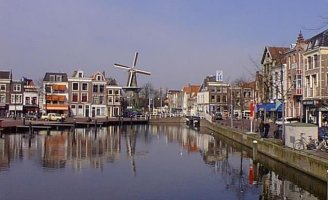
LEIDEN:
The city I was born and raised:
The City of Leiden has a rich history. Most notable was the brave
defense by its inhabitants during the siege by Spanish troops,
and their liberation on the 3rd of October 1574 after months of
hunger and disease. The 3rd of October is still celebrated by
eating herring, white bread, and hutspot.
Leiden boomed in the 17th century when it was the second largest
city in Holland, after Amsterdam.
The beautiful city center with its canals and singels is still
dominated by various monuments, 17th century mansions and facades.
Famous buildings include the Lakenhal, Burcht, Pieterskerk, Hooglandse
Kerk, Academy building, and two old city gates.
The city also has a great many rustic courts (hofjes), founded
as alms houses, but now partly occupied by students.
The city has a variety of well-known museums, such as the National
Museum of Antiquities, the Ethnology Museum and the Municipal
Lakenhal Museum with paintings of Jan Steen, Lucas van Leyden
and Rembrandt, who was born in Leiden.
The Boerhaave Museum, the National Museum of the History of Science
and Medicine, deserves special attention. It was recently housed
in the restored Caecilia Hospital, where Herman Boerhaave gave
his famous bedside teaching.
The museum has in its collections the early microscope of Van
Leeuwenhoek, clocks and other instruments of Chr. Huygens and
the helium refrigeration equipment of Kamerlingh Onnes.
Many of its astronomical exhibits are centered on instruments
on loan from the Sterrewacht.
Leiden is now a medium size city (111,000 inhabitants) in the
west of The Netherlands, with excellent connections to Schiphol
Airport, Amsterdam, The Hague, and Rotterdam. This offers the
unique possibility of profiting from the culture and pleasure
that these cities have to offer, in addition to the museums and
the pubs of Leiden itself.
Many new office buildings signify Leiden's participation in economic
growth and activity.
In the immediate vicinity there are great opportunities for recreation:
the North Sea beach and dunes, lakes for sailing and windsurfing,
and in spring the richly colored tulip fields.
The relief of Leiden:
'Here's a knife. Go ahead and eat me.' These are legendary
words spoken by the mayor of Leiden to his starving citizins in
1574 when they were about to surrender to the Spanish.
His heroic behaviour kept them alive, resulting in the Relief
of Leiden. To express his appreciation, William of Orange gave
the town its university,
thereby laying the foundation for Leiden to become a museum town.
To end the siege by the Spanish, the Prince of Orange gave orders
to open the dikes. When the water approached Leiden on 2 October
1574, the Spanish fled en masse.
A boy named Cornelis Joppenszoon sneaked through the gates to
Lammenschans to see if they had really left. All he found was
a smouldering fire with a stew of carrots, onions and meat simmering
on top. This hutspot has since been associated with Leiden ever
since.
The relief of Leiden is celebrated each year on October 2nd and
3rd all over the city, there will be live music, a parade and
fair etc.
Museums in Leiden:
National Museum of Antiquities
Museum Boerhaave
Naturalis
Homepage of the city of Leiden
Back to:
Monica's page
Dutch info page
index
HOME



